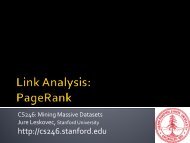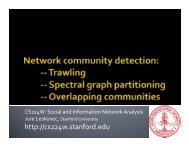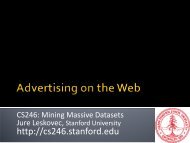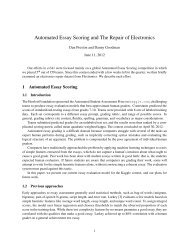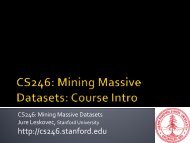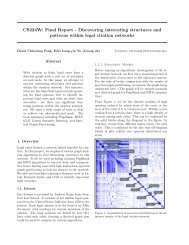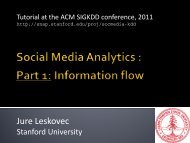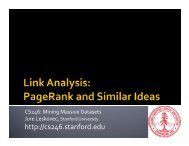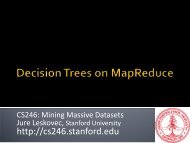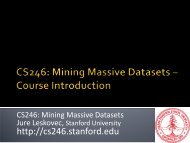Jure Leskovec, Stanford University - SNAP - Stanford University
Jure Leskovec, Stanford University - SNAP - Stanford University
Jure Leskovec, Stanford University - SNAP - Stanford University
Create successful ePaper yourself
Turn your PDF publications into a flip-book with our unique Google optimized e-Paper software.
CS246: Mining Massive Datasets<br />
<strong>Jure</strong> <strong>Leskovec</strong>, <strong>Stanford</strong> <strong>University</strong><br />
http://cs246.stanford.edu
Overlaps with machine learning, statistics,<br />
artificial intelligence, databases, visualization<br />
but more stress on<br />
scalability of number<br />
of features and instances<br />
stress on algorithms and<br />
architectures<br />
automation for handling<br />
large data<br />
Statistics/<br />
AI<br />
Data Mining<br />
Database<br />
systems<br />
Machine Learning/<br />
Pattern<br />
Recognition<br />
3/9/2011 <strong>Jure</strong> <strong>Leskovec</strong>, <strong>Stanford</strong> C246: Mining Massive Datasets<br />
2
MapReduce<br />
Association Rules<br />
Finding Similar Items<br />
Locality Sensitive Hashing<br />
Dim. Reduction (SVD, CUR))<br />
Clustering<br />
Recommender systems<br />
PageRank and TrustRank<br />
Machine Learning: kNN, SVM, Decision Trees<br />
Mining data streams<br />
Advertising on the Web<br />
3/9/2011 <strong>Jure</strong> <strong>Leskovec</strong>, <strong>Stanford</strong> C246: Mining Massive Datasets 3
3/9/2011 <strong>Jure</strong> <strong>Leskovec</strong>, <strong>Stanford</strong> C246: Mining Massive Datasets 4
The crew of the space shuttle<br />
Endeavor recently returned to<br />
Earth as ambassadors,<br />
harbingers of a new era of<br />
space exploration. Scientists<br />
at NASA are saying that the<br />
recent assembly of the Dextre<br />
bot is the first step in a longterm<br />
space-based<br />
man/machine partnership.<br />
'"The work we're doing now -the<br />
robotics we're doing -- is<br />
what we're going to need to<br />
do to build any work station<br />
or habitat structure on the<br />
moon or Mars," said Allard<br />
Beutel.<br />
Big document<br />
Provided by the<br />
programmer<br />
MAP:<br />
reads input and<br />
produces a set of<br />
key value pairs<br />
(the, 1)<br />
(crew, 1)<br />
(of, 1)<br />
(the, 1)<br />
(space, 1)<br />
(shuttle, 1)<br />
(Endeavor, 1)<br />
(recently, 1)<br />
….<br />
(key, value)<br />
Group by key:<br />
Collect all pairs<br />
with same key<br />
(crew, 1)<br />
(crew, 1)<br />
(space, 1)<br />
(the, 1)<br />
(the, 1)<br />
(the, 1)<br />
(shuttle, 1)<br />
(recently, 1)<br />
…<br />
(key, value)<br />
Provided by the<br />
programmer<br />
Reduce:<br />
Collect all values<br />
belonging to the<br />
key and output<br />
(crew, 2)<br />
(space, 1)<br />
(the, 3)<br />
(shuttle, 1)<br />
(recently, 1)<br />
…<br />
(key, value)<br />
3/9/2011 <strong>Jure</strong> <strong>Leskovec</strong>, <strong>Stanford</strong> C246: Mining Massive Datasets<br />
5<br />
Sequentially read the data<br />
Only sequential reads
High-dimensional data:<br />
Locality Sensitive Hashing<br />
Dimensionality reduction<br />
Clustering<br />
The data is a graph:<br />
Link Analysis: PageRank, TrustRank, Hubs & Authorities<br />
Machine Learning:<br />
kNN, Perceptron, SVM, Decision Trees<br />
Data is infinite:<br />
Mining data streams<br />
Advertising on the Web<br />
Applications:<br />
Association Rules<br />
Recommender systems<br />
3/9/2011 <strong>Jure</strong> <strong>Leskovec</strong>, <strong>Stanford</strong> C246: Mining Massive Datasets<br />
6
Many problems can be expressed as finding<br />
“similar” sets:<br />
Find near-neighbors in high-D space<br />
Distance metrics:<br />
Points in ℜ n : L1, L2, Manhattan distance<br />
Vectors: Cosine similarity<br />
Sets of items: Jaccard similarity, Hamming distance<br />
Problem:<br />
Find near-duplicate documents<br />
3/9/2011 <strong>Jure</strong> <strong>Leskovec</strong>, <strong>Stanford</strong> C246: Mining Massive Datasets 7
Document<br />
The set of strings<br />
of length k that<br />
appear in the<br />
document<br />
Signatures : short<br />
integer vectors that<br />
represent the sets,<br />
and reflect their<br />
similarity<br />
Localitysensitive<br />
Hashing<br />
1. Shingling: convert docs to sets<br />
2. Minhashing: convert large sets to short<br />
signatures, while preserving similarity.<br />
3. Locality-sensitive hashing: focus on pairs of<br />
signatures likely to be similar<br />
Candidate<br />
pairs :<br />
those pairs<br />
of signatures<br />
that we need<br />
to test for<br />
similarity.<br />
3/9/2011 <strong>Jure</strong> <strong>Leskovec</strong>, <strong>Stanford</strong> C246: Mining Massive Datasets 8
Shingling: convert docs to sets of items<br />
Shingle: sequence of k tokens that appear in doc<br />
Example: k=2; D 1= abcab, 2-shingles: S(D 1)={ab, bc, ca}<br />
Represent a doc by the set of hashes of its shingles<br />
MinHashing: convert large sets to short<br />
signatures, while preserving similarity<br />
Similarity preserving hash func. h() s.t.:<br />
Pr[h π(S(D 1)) = h π(S(D 2))] = Sim(S(D 1), S(D 2))<br />
For Jaccard use permutation of columns and index of first 1.<br />
3/9/2011 <strong>Jure</strong> <strong>Leskovec</strong>, <strong>Stanford</strong> C246: Mining Massive Datasets 9
1<br />
3<br />
7<br />
6<br />
2<br />
5<br />
4<br />
4<br />
2<br />
1<br />
3<br />
6<br />
7<br />
5<br />
3<br />
4<br />
7<br />
6<br />
1<br />
2<br />
5<br />
1<br />
1<br />
0<br />
0<br />
0<br />
1<br />
1<br />
Input matrix<br />
0<br />
0<br />
1<br />
1<br />
1<br />
0<br />
0<br />
3/9/2011 <strong>Jure</strong> <strong>Leskovec</strong>, <strong>Stanford</strong> C246: Mining Massive Datasets<br />
1<br />
0<br />
0<br />
0<br />
0<br />
1<br />
1<br />
0<br />
1<br />
1<br />
1<br />
1<br />
0<br />
0<br />
Signature matrix M<br />
2<br />
2<br />
1<br />
1<br />
1<br />
2<br />
Similarities:<br />
1-3 2-4 1-2 3-4<br />
Col/Col 0.75 0.75 0 0<br />
Sig/Sig 0.67 1.00 0 0<br />
2<br />
4<br />
1<br />
1<br />
1<br />
2<br />
10
ands<br />
Hash cols of signature<br />
matrix M: Similar columns<br />
likely hash to same bucket<br />
Cols. x and y are a candidate<br />
pair if M (i, x) = M (i, y) for at<br />
least frac. s values of i<br />
Divide matrix M into b bands<br />
of r rows<br />
r rows<br />
Buckets<br />
Matrix M<br />
Prob. of sharing<br />
a bucket<br />
Sim(C 1 ,C 2)=s<br />
Prob. that at least 1 band is<br />
identical = 1 - (1 - s r ) b<br />
Given s, tune r and b to get<br />
almost all pairs with similar<br />
signatures, but eliminate<br />
most pairs that do not have<br />
similar signatures<br />
Sim. threshold s<br />
b=20, r=5<br />
s 1-(1-s r ) b<br />
.2 .006<br />
.3 .047<br />
.4 .186<br />
.5 .470<br />
.6 .802<br />
.7 .975<br />
.8 .9996<br />
3/9/2011 <strong>Jure</strong> <strong>Leskovec</strong>, <strong>Stanford</strong> C246: Mining Massive Datasets 11<br />
2<br />
1<br />
2<br />
1<br />
2<br />
1<br />
4<br />
1<br />
2<br />
1<br />
2<br />
1
m<br />
n<br />
A<br />
≈<br />
m<br />
3/9/2011 <strong>Jure</strong> <strong>Leskovec</strong>, <strong>Stanford</strong> C246: Mining Massive Datasets 12<br />
U<br />
Σ<br />
n<br />
V T
SciFi<br />
Romnce<br />
A = U Σ V T - example:<br />
Matrix<br />
Alien<br />
Serenity<br />
Casablanca<br />
Amelie<br />
1 1 1 0 0<br />
2 2 2 0 0<br />
1 1 1 0 0<br />
5 5 5 0 0<br />
0 0 0 2 2<br />
0 0 0 3 3<br />
0 0 0 1 1<br />
=<br />
SciFi-concept<br />
0.18 0<br />
0.36 0<br />
0.18 0<br />
0.90 0<br />
0 0.53<br />
0 0.80<br />
0 0.27<br />
Romance-concept<br />
9.64 0<br />
0 5.29<br />
3/9/2011 <strong>Jure</strong> <strong>Leskovec</strong>, <strong>Stanford</strong> C246: Mining Massive Datasets 13<br />
x<br />
user-to-concept<br />
similarity matrix<br />
x<br />
0.58 0.58 0.58 0 0<br />
0 0 0 0.71 0.71
SciFi<br />
Romnce<br />
A = U Σ V T - example:<br />
Matrix<br />
Alien<br />
Serenity<br />
Casablanca<br />
Amelie<br />
1 1 1 0 0<br />
2 2 2 0 0<br />
1 1 1 0 0<br />
5 5 5 0 0<br />
0 0 0 2 2<br />
0 0 0 3 3<br />
0 0 0 1 1<br />
=<br />
0.18 0<br />
0.36 0<br />
0.18 0<br />
0.90 0<br />
0 0.53<br />
0 0.80<br />
0 0.27<br />
‘strength’ of SciFi-concept<br />
9.64 0<br />
0 5.29<br />
3/9/2011 <strong>Jure</strong> <strong>Leskovec</strong>, <strong>Stanford</strong> C246: Mining Massive Datasets 14<br />
x<br />
x<br />
0.58 0.58 0.58 0 0<br />
0 0 0 0.71 0.71
SciFi<br />
Romnce<br />
A = U Σ V T - example:<br />
Matrix<br />
Alien<br />
Serenity<br />
Casablanca<br />
Amelie<br />
1 1 1 0 0<br />
2 2 2 0 0<br />
1 1 1 0 0<br />
5 5 5 0 0<br />
0 0 0 2 2<br />
0 0 0 3 3<br />
0 0 0 1 1<br />
=<br />
0.18 0<br />
0.36 0<br />
0.18 0<br />
0.90 0<br />
0 0.53<br />
0 0.80<br />
0 0.27<br />
SciFi-concept<br />
9.64 0<br />
0 5.29<br />
3/9/2011 <strong>Jure</strong> <strong>Leskovec</strong>, <strong>Stanford</strong> C246: Mining Massive Datasets 15<br />
x<br />
movie-to-concept<br />
similarity matrix<br />
x<br />
0.58 0.58 0.58 0 0<br />
0 0 0 0.71 0.71
How to do dimensionality reduction:<br />
Set small singular values to zero<br />
How to query?<br />
Map query vector into “concept space” –<br />
How? Compute q∙V<br />
d= 0 4 5 0 0<br />
1.16 0<br />
q=<br />
Matrix<br />
Alien<br />
Serenity<br />
Casablanca<br />
Amelie<br />
5 0 0 0 0<br />
Even though d and q do not share<br />
a movie, they are still similar<br />
SciFi-concept<br />
0.58 0<br />
3/9/2011 <strong>Jure</strong> <strong>Leskovec</strong>, <strong>Stanford</strong> C246: Mining Massive Datasets 16
Hierarchical:<br />
Agglomerative (bottom up):<br />
Initially, each point is a cluster<br />
Repeatedly combine the two<br />
“nearest” clusters into one<br />
Represent a cluster by its<br />
centroid or clustroid<br />
Point Assignment:<br />
Maintain a set of clusters<br />
Points belong to “nearest” cluster<br />
3/9/2011 <strong>Jure</strong> <strong>Leskovec</strong>, <strong>Stanford</strong> C246: Mining Massive Datasets<br />
17
k-means: initialize cluster centroids<br />
Iterate:<br />
For each point, place it in the cluster whose current<br />
centroid it is nearest<br />
Update the cluster centroids based on memberships<br />
7<br />
Reassigned<br />
points<br />
5<br />
x<br />
3<br />
1<br />
3/9/2011 <strong>Jure</strong> <strong>Leskovec</strong>, <strong>Stanford</strong> C246: Mining Massive Datasets 18<br />
8<br />
6<br />
x<br />
4<br />
2<br />
Clusters after first round
LSH:<br />
Find somewhat similar pairs of items while avoiding<br />
O(N 2 ) comparisons<br />
Clustering:<br />
Assign points into a prespecified number of clusters<br />
Each point belongs to a single cluster<br />
Summarize the cluster by a centroid (e.g., topic vector)<br />
SVD (dimensionality reduction):<br />
Want to explore correlations in the data<br />
Some dimensions may be irrelevant<br />
Useful for visualization, removing noise from the data,<br />
detecting anomalies<br />
3/9/2011 <strong>Jure</strong> <strong>Leskovec</strong>, <strong>Stanford</strong> C246: Mining Massive Datasets 19
High-dimensional data:<br />
Locality Sensitive Hashing<br />
Dimensionality reduction<br />
Clustering<br />
The data is a graph:<br />
Link Analysis: PageRank, TrustRank, Hubs & Authorities<br />
Machine Learning:<br />
kNN, Perceptron, SVM, Decision Trees<br />
Data is infinite:<br />
Mining data streams<br />
Advertising on the Web<br />
Applications:<br />
Association Rules<br />
Recommender systems<br />
3/9/2011 <strong>Jure</strong> <strong>Leskovec</strong>, <strong>Stanford</strong> C246: Mining Massive Datasets<br />
20
Rank nodes using link structure<br />
PageRank:<br />
Link voting:<br />
P with importance x has n out-links, each link gets x/n votes<br />
Page R’s importance is the sum of the votes on its in-links<br />
Complications: Spider traps, Dead-ends<br />
At each step, random surfer has two options:<br />
With probability β, follow a link at random<br />
With prob. 1-β, jump to some page uniformly at random<br />
3/9/2011 <strong>Jure</strong> <strong>Leskovec</strong>, <strong>Stanford</strong> C246: Mining Massive Datasets 21
TrustRank: topic-specific PageRank with a<br />
teleport set of “trusted” pages<br />
Spam mass of page p:<br />
Fraction of pagerank score r(p) coming from spam pages:<br />
|r(p) – r + (p)| / r(p)<br />
SimRank: measure similarity between items<br />
a k-partite graph with k types of nodes<br />
Example: picture nodes and tag nodes<br />
Perform a random-walk with restarts from node N<br />
i.e., teleport set = {N}.<br />
Resulting prob. distribution measures similarity to N<br />
3/9/2011 <strong>Jure</strong> <strong>Leskovec</strong>, <strong>Stanford</strong> C246: Mining Massive Datasets 22
HITS (Hypertext-Induced Topic Selection ) is a<br />
measure of importance of pages or documents,<br />
similar to PageRank:<br />
Authorities are pages containing useful information<br />
E.g., course home pages<br />
Hubs are pages that link to authorities<br />
On-line list of links to CS courses.<br />
Mutually recursive definition:<br />
A good hub links to many good authorities<br />
A good authority is linked from many good hubs<br />
Model using two scores for each node:<br />
Hub score h and Authority score a<br />
3/9/2011 <strong>Jure</strong> <strong>Leskovec</strong>, <strong>Stanford</strong> C246: Mining Massive Datasets 23
PageRank and HITS are two solutions to the<br />
same problem:<br />
What is the value of an in-link from u to v?<br />
In the PageRank model, the value of the link<br />
depends on the links into u<br />
In the HITS model, it depends on the value of the<br />
other links out of u<br />
PageRank gives flexibility with teleportation<br />
3/9/2011 <strong>Jure</strong> <strong>Leskovec</strong>, <strong>Stanford</strong> C246: Mining Massive Datasets<br />
24
High-dimensional data:<br />
Locality Sensitive Hashing<br />
Dimensionality reduction<br />
Clustering<br />
The data is a graph:<br />
Link Analysis: PageRank, TrustRank, Hubs & Authorities<br />
Machine Learning:<br />
kNN, Perceptron, SVM, Decision Trees<br />
Data is infinite:<br />
Mining data streams<br />
Advertising on the Web<br />
Applications:<br />
Association Rules<br />
Recommender systems<br />
3/9/2011 <strong>Jure</strong> <strong>Leskovec</strong>, <strong>Stanford</strong> C246: Mining Massive Datasets<br />
25
Would like to do prediction:<br />
estimate a function f(x) so that y = f(x)<br />
Where y can be:<br />
Real number: Regression<br />
Categorical: Classification<br />
Data is labeled: have many pairs {(x, y)}<br />
x … vector of real valued features<br />
y … class ({+1, -1}, or a real number)<br />
Methods:<br />
k-Nearest Neighbor<br />
Support Vector Machines<br />
Decision trees<br />
3/9/2011 <strong>Jure</strong> <strong>Leskovec</strong>, <strong>Stanford</strong> C246: Mining Massive Datasets 26
Distance metric:<br />
Euclidean<br />
How many neighbors to look at?<br />
All of them (!)<br />
Weighting function:<br />
wi = exp(-d(xi, q) 2 d(xi, q) = 0<br />
/Kw) Nearby points to query q are weighted more strongly. Kw…kernel width.<br />
How to fit with the local points?<br />
Predict weighted average: Σwiyi/Σwi K=10 K=20 K=80<br />
3/9/2011 <strong>Jure</strong> <strong>Leskovec</strong>, <strong>Stanford</strong> C246: Mining Massive Datasets 27<br />
w i
Prediction = sign(w⋅x + b)<br />
Model parameters w, b<br />
w 1<br />
Margin: γ = =<br />
w⋅<br />
w w<br />
SVM optimization problem:<br />
min<br />
w,<br />
b,<br />
ξ ≥0<br />
s.<br />
t.<br />
∀i,<br />
i<br />
1<br />
2<br />
y<br />
i<br />
w<br />
( w⋅<br />
n<br />
+ C∑<br />
i=<br />
1<br />
Find w,b using Stochastic<br />
gradient descent<br />
2<br />
x<br />
i<br />
ξ<br />
+ b)<br />
≥1<br />
−ξ<br />
i<br />
+ +<br />
3/9/2011 <strong>Jure</strong> <strong>Leskovec</strong>, <strong>Stanford</strong> C246: Mining Massive Datasets 28<br />
i<br />
+<br />
+<br />
+<br />
+<br />
+<br />
- ξ i<br />
ξ i<br />
-<br />
-<br />
-<br />
+<br />
-
Building decision trees<br />
using MapReduce<br />
How to predict?<br />
Predictor: avg. y i of the<br />
examples in the leaf<br />
When to stop?<br />
# of examples in the leaf is small<br />
How to build?<br />
One MapReduce job per level<br />
Need to compute split quality<br />
for each attribute and each split<br />
value for each current leaf<br />
3/9/2011 <strong>Jure</strong> <strong>Leskovec</strong>, <strong>Stanford</strong> C246: Mining Massive Datasets 29<br />
|D|=10<br />
A<br />
|D|=90<br />
.42 B<br />
X1
SVM: classification<br />
Millions of numerical features (e.g., documents)<br />
Simple (linear) decision boundary<br />
Hard to interpret model<br />
kNN: classification or regression<br />
(Many) numerical features<br />
Many parameters to play with –distance metric, k,<br />
weighting, … there is no simple way to set them!<br />
Decision Trees: classification or regression<br />
Relatively few features (handles categorical features)<br />
Complicated decision boundary<br />
Overfitting can be a problem<br />
Easy to explain/interpret the classification<br />
3/9/2011 <strong>Jure</strong> <strong>Leskovec</strong>, <strong>Stanford</strong> C246: Mining Massive Datasets 30
High-dimensional data:<br />
Locality Sensitive Hashing<br />
Dimensionality reduction<br />
Clustering<br />
The data is a graph:<br />
Link Analysis: PageRank, TrustRank, Hubs & Authorities<br />
Machine Learning:<br />
kNN, Perceptron, SVM, Decision Trees<br />
Data is infinite:<br />
Mining data streams<br />
Advertising on the Web<br />
Applications:<br />
Association Rules<br />
Recommender systems<br />
3/9/2011 <strong>Jure</strong> <strong>Leskovec</strong>, <strong>Stanford</strong> C246: Mining Massive Datasets<br />
31
. . . 1, 5, 2, 7, 0, 9, 3<br />
. . . a, r, v, t, y, h, b<br />
. . . 0, 0, 1, 0, 1, 1, 0<br />
time<br />
Streams Entering<br />
Limited<br />
Working<br />
Storage<br />
Ad-Hoc<br />
Queries<br />
Standing<br />
Queries<br />
Processor<br />
Archival<br />
Storage<br />
Output<br />
3/9/2011 <strong>Jure</strong> <strong>Leskovec</strong>, <strong>Stanford</strong> C246: Mining Massive Datasets 32
Can’t store the whole stream but we are<br />
happy with an approximate answer<br />
Sampling data from a stream:<br />
Sample of size k: each element is included with prob. k/N<br />
Queries over sliding windows:<br />
How many 1s are in last k bits?<br />
DGIM: summarize blocks with specific number of 1s<br />
To estimate the number of 1s in the most recent N bits:<br />
Sum the sizes of all buckets but the last<br />
Add half the size of the last bucket<br />
1001010110001011010101010101011010101010101110101010111010100010110010<br />
3/9/2011 <strong>Jure</strong> <strong>Leskovec</strong>, <strong>Stanford</strong> C246: Mining Massive Datasets 33
Filtering a stream:<br />
Select elements with<br />
property x from stream<br />
Bloom filters<br />
Counting distinct elements:<br />
Number of distinct elements in<br />
the last k elements of the stream<br />
Flajolet-Martin:<br />
Item<br />
hash<br />
func h<br />
0010001011000<br />
Drop the item<br />
For each item a, let r(a) be the # of trailing 0s in h(a)<br />
Record R = the maximum r(a) seen<br />
R = max a r(a), over all the items a seen so far<br />
Estimated number of distinct elements = 2 R<br />
Output the<br />
item since it<br />
may be in S;<br />
Bit<br />
array B<br />
3/9/2011 <strong>Jure</strong> <strong>Leskovec</strong>, <strong>Stanford</strong> C246: Mining Massive Datasets 34
You get to see one input piece<br />
at a time, and need to make<br />
irrevocable decisions<br />
Competitive ratio =<br />
min all inputs I (|M my_alg|/|M opt|)<br />
Greedy online matching:<br />
competitive ratio= |M greedy|/|M opt| ≥ 1/2<br />
Addwords problem:<br />
Query arrives to a search engine<br />
Several advertisers bid on the query query<br />
Pick a subset of advertisers whose ads are shown<br />
3/9/2011 <strong>Jure</strong> <strong>Leskovec</strong>, <strong>Stanford</strong> C246: Mining Massive Datasets 35<br />
1<br />
2<br />
3<br />
4<br />
a<br />
b<br />
c<br />
d<br />
Boys Girls
BALANCE Algorithm:<br />
For each query, pick the advertiser with the<br />
largest unspent budget<br />
Break ties arbitrarily (in a deterministic way)<br />
Two advertisers A and B<br />
A bids on query x, B bids on x and y<br />
Both have budgets of $4<br />
Query stream: xxxxyyyy<br />
BALANCE choice: ABABBB__<br />
Optimal: AAAABBBB, Competitive ratio = ¾<br />
Generally, competitive ratio = 1-1/e<br />
3/9/2011 <strong>Jure</strong> <strong>Leskovec</strong>, <strong>Stanford</strong> C246: Mining Massive Datasets 36
High-dimensional data:<br />
Locality Sensitive Hashing<br />
Dimensionality reduction<br />
Clustering<br />
The data is a graph:<br />
Link Analysis: PageRank, TrustRank, Hubs & Authorities<br />
Machine Learning:<br />
kNN, Perceptron, SVM, Decision Trees<br />
Data is infinite:<br />
Mining data streams<br />
Advertising on the Web<br />
Applications:<br />
Association Rules<br />
Recommender systems<br />
3/9/2011 <strong>Jure</strong> <strong>Leskovec</strong>, <strong>Stanford</strong> C246: Mining Massive Datasets<br />
37
Supermarket shelf management – Market-basket<br />
model:<br />
Goal: To identify items that are bought together<br />
by sufficiently many customers<br />
Approach: Process the sales data collected with<br />
barcode scanners to find dependencies among<br />
items<br />
TID Items<br />
1 Bread, Coke, Milk<br />
2 Beer, Bread<br />
3 Beer, Coke, Diaper, Milk<br />
4 Beer, Bread, Diaper, Milk<br />
5 Coke, Diaper, Milk<br />
Rules Discovered:<br />
{Milk} --> {Coke}<br />
{Diaper, Milk} --> {Beer}<br />
3/9/2011 <strong>Jure</strong> <strong>Leskovec</strong>, <strong>Stanford</strong> C246: Mining Massive Datasets 38
Observation: Subsets of a frequent itemset are freq<br />
Consequence: Build frequent itemsets bottom up<br />
Example: Items = {milk, coke, pepsi, beer, juice}<br />
Min Support = 3 baskets<br />
B 1 = {m, c, b} B 2 = {m, c, j}<br />
B 3 = {m, b} B 4= {c, j}<br />
B 5 = {m, p, b} B 6 = {m, c, b, j}<br />
B 7 = {c, b, j} B 8 = {b, c}<br />
Frequent 1-sets: {m}, {c}, {b}, {j}<br />
Frequent 2-sets: {m,c}, {m,b}, {m,j}, {c,b}, {c,j}, {b,j}<br />
Need not even consider sets {p, *} as {p} is not frequent<br />
Frequent 3-sets: only need to check {m, c, b}<br />
3/9/2011 <strong>Jure</strong> <strong>Leskovec</strong>, <strong>Stanford</strong> C246: Mining Massive Datasets 39
Content based approach:<br />
recommend<br />
likes<br />
match<br />
Item profiles<br />
Red<br />
Circles<br />
Triangles<br />
User profile<br />
build<br />
3/9/2011 <strong>Jure</strong> <strong>Leskovec</strong>, <strong>Stanford</strong> C246: Mining Massive Datasets 40
User-user collaborative filtering<br />
Consider user c<br />
Find set D of other users whose ratings are<br />
“similar” to c’s ratings<br />
Estimate user’s ratings based on the ratings of<br />
users in D<br />
Item-item collaborative filtering<br />
Estimate rating for item based on ratings for<br />
similar items<br />
3/9/2011 <strong>Jure</strong> <strong>Leskovec</strong>, <strong>Stanford</strong> C246: Mining Massive Datasets 41
CS246: Mining Massive Datasets<br />
<strong>Jure</strong> <strong>Leskovec</strong>, <strong>Stanford</strong> <strong>University</strong><br />
http://cs246.stanford.edu
MapReduce<br />
Association Rules<br />
Apriori algorithm<br />
Finding Similar Items<br />
Locality Sensitive Hashing<br />
Random Hyperplanes<br />
Dimensionality Reduction<br />
Singular Value Decomposition<br />
CUR method<br />
Clustering<br />
Recommender systems<br />
Collaborative filtering<br />
PageRank and TrustRank<br />
Hubs & Authorities<br />
k-Nearest Neighbors<br />
Perceptron<br />
Support Vector Machines<br />
Stochastic Gradient Descent<br />
Decision Trees<br />
Mining data streams<br />
Bloom Filters<br />
Flajolet-Martin<br />
Advertising on the Web<br />
3/9/2011 <strong>Jure</strong> <strong>Leskovec</strong>, <strong>Stanford</strong> C246: Mining Massive Datasets 43
How to analyze large datasets to discover<br />
patterns and models that are:<br />
valid: hold on new data with some certainty<br />
novel: non-obvious to the system<br />
useful: should be possible to act on the item<br />
understandable: humans should be able to<br />
interpret the pattern<br />
How to do this using massive data (that does<br />
not fit into main memory)<br />
3/9/2011 <strong>Jure</strong> <strong>Leskovec</strong>, <strong>Stanford</strong> C246: Mining Massive Datasets 44
Seminars:<br />
InfoSeminar: http://i.stanford.edu/infoseminar<br />
RAIN Seminar: http://rain.stanford.edu<br />
Conferences:<br />
KDD: ACM Conference on Knowledge Discovery and Data Mining<br />
ICDM: IEEE International Conference on Data Mining<br />
WWW: World Wide Web Conference<br />
ICML: International Conference on Machine Learning<br />
NIPS: Neural Information Processing Systems<br />
Some courses:<br />
CS341: Research Project in Data Mining<br />
CS224W: Social and Information Network Analysis<br />
CS276: Information Retrieval and Web Search<br />
CS229: Machine Learning<br />
CS448g: Interactive Data Analysis<br />
3/9/2011 <strong>Jure</strong> <strong>Leskovec</strong>, <strong>Stanford</strong> C246: Mining Massive Datasets 45
And (hopefully) learned a lot!!!<br />
Implemented a number of methods<br />
Answered questions and proved many<br />
interesting results<br />
And did excellently on the final!<br />
Thank You for the<br />
Hard Work!!!<br />
3/9/2011 <strong>Jure</strong> <strong>Leskovec</strong>, <strong>Stanford</strong> C246: Mining Massive Datasets 46




